How To Dye Mosaic Tile Grout

Dyeing Mosaic Grout Tips
By Troy Cantini
Mosaic tiles are surrounded by a lot of grout so if the grout gets stained then the entire mosaic tile installation will not look good. The best way to give the grout a clean, uniform look and appearance is to dye the grout. Dyeing the grout you will also seal and protection the grout from becoming dirty and stained. Dyeing mosaic tile grout works best when the tiles are non porous tiles like ceramic, porcelain or mosaic glass tiles.
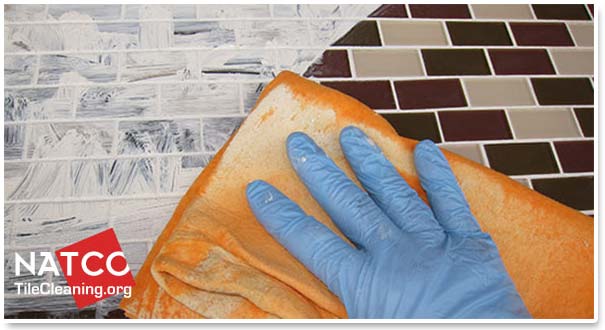
Trying to dye grout between porous stone tiles will likely discolor the porous stone tiles. With non porous ceramic, porcelain and glass mosaic tiles the grout dye will not be absorbed by the tiles so you do not have to worry about altering the appearance of these types of tiles. Stone tiles on the other had will absorb the grout dye and it is impossible to restore the original look of the stone tiles. In some cases dyeing the stone tiles will not make them look bad but it is up to the home owner to decide if they like the look of their stone tiles after they have been dyed. A small out of the way tile can be used to test the effect of the dye on the stone tiles to see if you want to dye the entire stone tile and grout installation.
Grout dye's come in many colors and most grout dye manufacturers have many colors to choose from. Usually most grout dye manufactures will have many colors from the popular grout manufacturers to choose from to match your existing grout. You will be completely changing the color of the existing grout so you should choose a color that you want and not necessarily the color of the existing grout.
Before you begin dyeing the grout you should first clean and prep the tiles and grout with a good degreaser. It is important to scrub the grout clean to remove any dirt, grease and grime that might interfere with the dye being absorbed into the grout. It is also a good idea to follow up the cleaning process with an acid wash of the grout. An acid wash will not damage man made ceramic, porcelain or glass tiles but it can etch any stone tiles that it comes in contact with. The acid wash is important for getting a good adhesion between the dye and the grout. The acid wash will also remove any stubborn stains and grout haze that was stuck to the surface of the tiles. If you are dyeing porous stone tile grout then you should skip the acid wash step or test the acidic cleaner on a spare tile to be sure you will not etch the stone tiles.
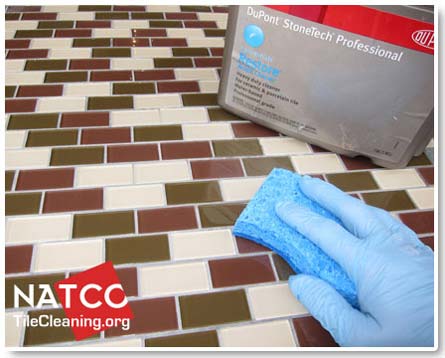
An acid wash of the mosaic tiles and grout involves simply applying an acid cleaner to the tiles and grout and then gently scrubbing the grout with a soft scrub pad. Abrasive scrub pads can scratch delicate mosaic tiles and glass tiles can easily be scratched with abrasive scrub pads.. You should see the grout lines get cleaner as the acid reacts with grout and removes many of the stubborn stains in the grout. You should then thoroughly rinse the tiles and grout to remove all traces of the acidic cleaner.
It is a good idea to allow the grout time to thoroughly dry out before dyeing it. Water in the grout can interfere with how the grout dye bonds with the grout. It is a good practice to allow the grout at least 24 hours time after cleaning it before you begin dyeing it. Grout dyes are water based products that will absorb deep into the grout to stain the color of the grout. Any water left in the grout will interfere with the grout dye being absorbed by the grout.
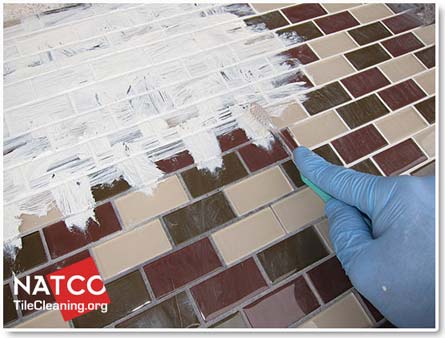
To apply the dye to the grout you can use a small toothbrush. With mosaic tiles it can sometimes make more sense to just pour the dye directly on all of the tiles and grout and use some sort of squeegee to wipe the excess grout dye off of the tiles. Pouring the dye directly on the tiles and grout will sometimes allow too much of the grout dye to accumulate in the grout lines giving the grout lines an unnatural painted on look. It is usually better to do the tedious task of applying the dye to each individual grout line. This will give you the most natural looking grout that retains the natural texture and look of the grout.
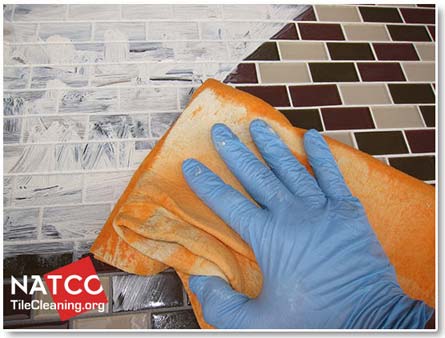
After you have dyed a section of grout then you need to remove the excess dye from the surface of the tiles. A soft, damp microfiber or chamois cloth works well to remove the excess dye from the tile surfaces. After the cloth has become saturated with dye then rinse it in a bucket of lukewarm water and continue wiping off the tiles.
A hazy film will develop on the tiles and become noticeable especially on glass mosaic tiles. This hazy film will be removed later after you have dyed all of the grout lines. Only dye enough of the grout lines so that you will have time to remove the excess dye before it hardens on the surface of the tiles. If you try to dye large sections of grout then removing the hardened grout dye will become extremely difficult.
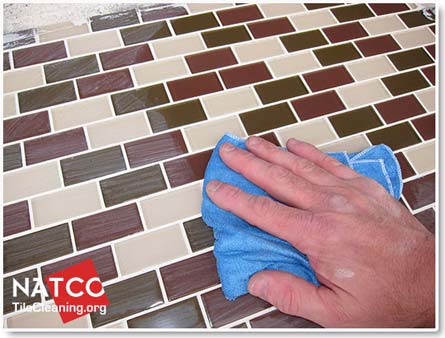
Cleaning the hazy dye film off the tile surfaces is the final step in the process. This hazy film can easily be removed with a soft, damp cotton towel or microfiber cloth. You should gently wipe the tiles to remove all traces of the haze. With glass mosaic tiles even the slightest haze can be visible on the tiles. You can use a small amount of a non ammonia glass cleaner on your cotton towel to help remove stubborn traces of grout dye on the tiles.
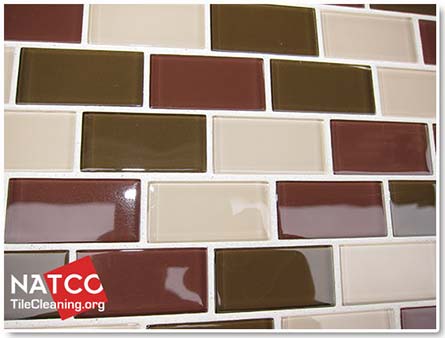
You should allow the dye at least 24 hours to fully cure before using the tiles. You should never have to seal the grout after it has been dyed. The grout dye will soak into the grout and seal the grout to keep dirt and stains from being absorbed by the grout. Any types of dirt or spills can simply be wiped away with a soft damp cotton wash cloth.
Aggressive cleaning products should never be used on dyed grout. A gentle Ph neutral tile and grout cleaning product and a soft scrub pad can be used periodically to remove any stubborn dried on dirt and stains on the tiles and grout. If properly cleaned and cared for the dyed grout will stay looking clean and new for at least 5-10 years and maybe more.
NATCO Related Articles>
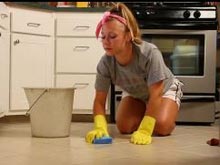 How To Clean Ceramic Tiles
How To Clean Ceramic Tiles
Ceramic tiles are typically easy to clean but the grout between the tiles is usually much more difficult to clean.
Read more»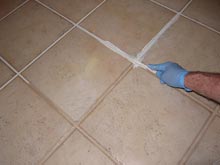 How To Paint Grout Lines
How To Paint Grout Lines
For extremely dirty and stained grout the best option for restoring the grout is to paint the grout lines.
Read more»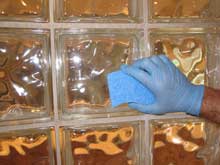 Cleaning Glass Shower Blocks
Cleaning Glass Shower Blocks
Use soft scrub pads and non abrasive cleaners to avoid scratching your glass shower blocks when cleaning them.
Read more»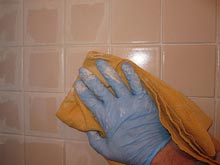 Colorsealing Shower Grout
Colorsealing Shower Grout
Dirty and dingy shower grout can be made to look new again when you colorseal the grout.
Read more»
